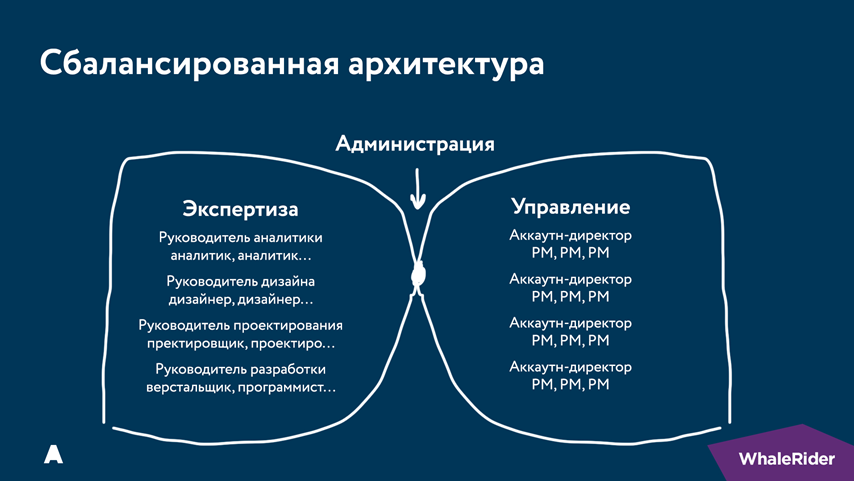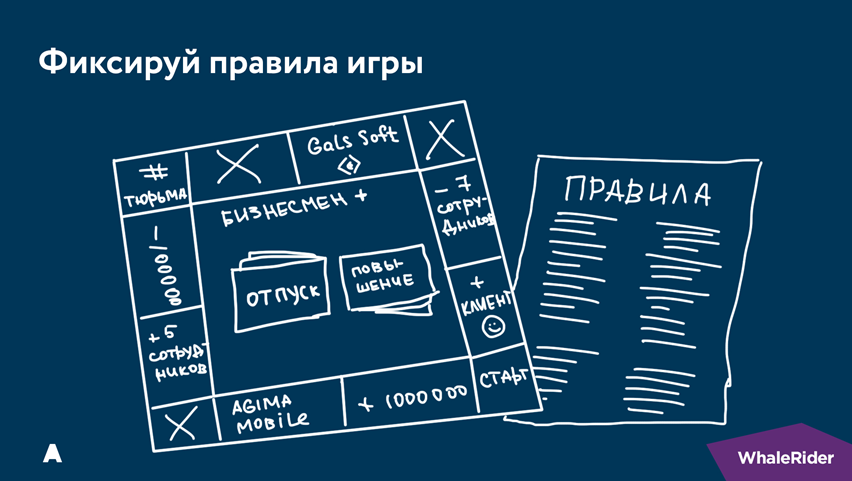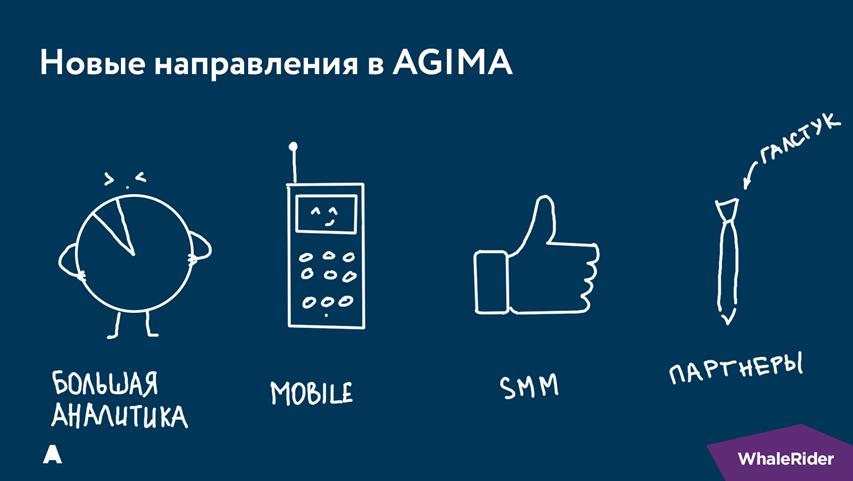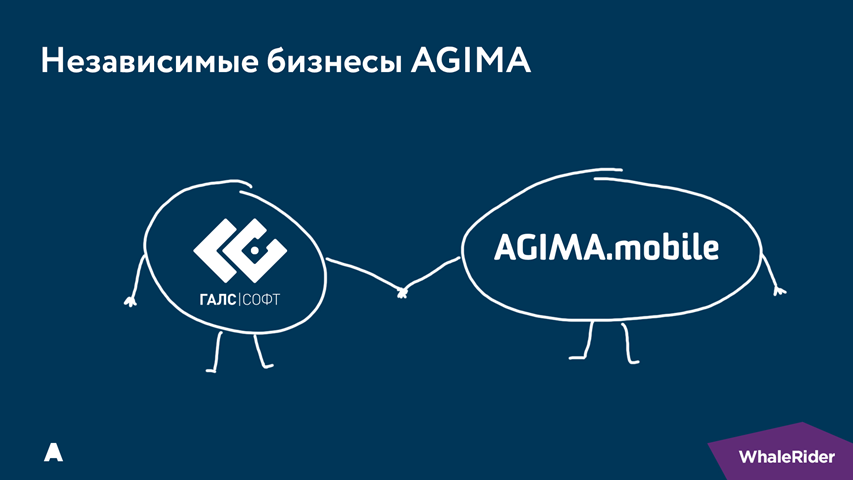Why business processes are not scary

Alexander Bogdanov ( AGIMA )
In fact, processes are people first. Probably, my report will be a little bit less about the systems with which you can automate processes, and more about the basic principles, the people who build these processes, and how these processes themselves must originate in an evolutionary way in a company.
I will tell on the experience of my company - the company AGIMA. I will tell you why I never bother much about automation, why processes arose themselves, automated themselves, and somehow everything was built by itself without any special, active participation in this — my or management team. Let me tell you why for us this is definitely a fearless experience.

')

First, we are 10 years old. We are very pleased. In fact, I did not expect that we have been in existence for so long. Before that, I did not have a company that is already 10 years old. There were several companies in one to two years of life. 10 years seemed like a long period, and in fact flew by instantly, but when you look back, you can see many interesting things for yourself - how, in fact, everything developed. It is possible to illustrate in two words:

10 years ago we had four employees, we made one product or provided one service, and we had an annual turnover of about 1 million rubles a year. To control such a team, we did not need anything.

We all sat in the same room, we could communicate directly with each other, we definitely didn’t need any bureaucratic means of communication and they would only interfere with us.

6 years ago we were already 25 employees, we still did one product or provided one service, the turnover was already equal to 20 million. And here, of course, we already needed something to manage such a team and the processes that are in it were happening.

But we, in principle, had a rather banal control system, i.e. we had a certain infrastructure at the level of mailing lists, all communications went in the mail - both with the client and among themselves - everything was recorded in the mail. And already then some general rules began to form, for example, how the workflow on the project happens, where to get some documentation, etc. These general rules existed on a common disk, and then this system suited us perfectly.

3 years ago we had 60 employees. There were three directions, it is clear that each direction is slightly different in processes between themselves. And about 70 million rubles, we had an annual turnover. Here it was a little more difficult to manage this story. And we began to emerge various wiki.

- The first wiki appeared by themselves from the developers - the developers began to describe the history of the project. All projects became longer and longer, longer, respectively, it was necessary to transfer knowledge. Then the wiki immigrated to management. In general, at some point, the wiki consumed all our procedures inside, starting from the reception desk and ending with testing. Everything is now going on in the wiki.
- Further, roles in the company began to be prescribed, since we already understood that, in principle, some of the employees in the company are quite typical specialists. We have to describe what roles they will have, approximately how much they should cost for us, how much they should issue prices from the product that they should give out at the output. And all of this can automatically begin with our HR-manager, who works for the hiring of such specialists, using the prescribed roles, and end with the fact that we control how these roles are performed.
- Further, all possible questions that are asked many times by our employees, we automatically entered into the FAQ. We have thus formed the FAQ.
- And some processes have already begun to receive the system, reflected in the documentation of the workflow - the site-production process, the project delivery process, the document flow - everything was just automatically fixed.

Now we have more than 120 employees in the company and, in principle, we cannot be called one company, we already have four companies to one degree or another involved. We have 10 directions and more than 220 million annual turnover. Of course, this must be managed in a completely different way than we managed a four-person company.

First, there was such a thing as corporate culture. You need to understand how your company differs from other companies like you in terms of HR policy. Especially when you start to compete not only with companies that are engaged in the same site-building, but you already compete with larger companies for money that do other things, but who are interested in your specialists. You must have your own corporate culture, you need to fix it, you need to water it, care for it, grow it, so that people really go to you, your company, your ecosystem.
You need to understand and clearly communicate to each employee what his career ladder is, what is waiting for him in general in the future. It does not have to be very clearly spelled out and detailed. Despite the fact that for some employees we have quite clear grades, the prospect must be clear to all employees that he will not sit in this place all his life.
Practically for each employee, a motivation system should be fixed so that it would be convenient to use it, respectively, if I come up with motivation for some link in the system, I can pass it on to the head of the relevant department, and he can use this motivation system everywhere, therefore for every employee we, too, everything is fixed.
Of course, clerical work, a large amount of documentation, especially when you are doing business in Russia, everyone understands this perfectly, there are a lot of documents, and the specificity of documents is large, so everything should also be spelled out.
Well, at some point you begin to document the infrastructure in the office, and then automate the use of office infrastructure, starting from booking reservations, etc. All this also occurs automatically when you have a turn of negotiations at some point. First, there is a piece of paper that is stuck to the talks, where people write the time, and then it automatically goes to google-documents, from a google-document at some point moves to Bitrix24.

In fact, the faster you grow, the faster you change. There is no other. But before I, in general, wanted to tell you how it all looks in detail, I wanted to answer the question of many: “Well, it's cool that you grow, and tell us how to grow quickly rather than tell us how to manage this rapid growth. ” Therefore, in a nutshell, I will tell you how, I believe, you can grow quickly, and then tell you how quickly you can change quickly.

First, I divided the growth into three large such pieces. First - it is necessary to establish a good incoming stream. Incoming flow of leads, applications - no matter how you call it.

Everything is very simple. It all starts with PR. I think PR is the most magnificent tool in our market. Moreover, many people ask me: “We haven’t done anything so cool yet, what are we going to PR'it, actually?”. In fact, PR'it is first of all not about your own cases, and PR'it needs your own approach, your vision, in general, your philosophy - this is an idea, new things that you want to use, projects that you believe in, etc. d. This is worthy of a PR at the first stage, and it already generates a fairly good flow of leads. Then it automatically happens - in sales, then - production, then cases are born. Actually, this is a constant story in which PR is born, which constantly gives you an incoming stream of leads.

And the second is the internal flow. At some point 3 years ago we refocused on it, i.e. prior to this, much attention was paid to the incoming flow, 3 years ago they shifted the attention vector to the internal flow, because better leads were born from it.
By the way, we posted publicly available videos from the WhaleRider 2015 and 2016 conferences. Here are the relevant sheets in our account - 2015 and 2016 in our YouTube account .
The internal flow is controlled mainly by managers, but in our case, we have assigned account directors with this role - these are our top managers, heads of management groups. The point is that the task of the account director is to manage his client portfolio, plan management staff for this client portfolio, but, most importantly, they plan the workload, they grab leads, form their ready-made orders. Together with the client, they complete the project and then provide PR to this project. And if you look at how we PR our projects, we always involve our clients and our employees in the PR projects, i.e. You can always see and see the real team. And we take our clients to the conference, they talk about our projects. In fact, so much attention to the client during the delivery of the project gives rise to a very good stream of further projects, we become at some point a close-knit family, where the pater familias of the family is our account director. And this very cool generates us a constant internal flow of leads.

As I said, I believe that PR is an indispensable tool for providing yourself with a constant stream of leads. And before you start a lot of PR and actively PR, the only way to provide yourself with really high-quality lead volume after your PR is to make sure that you yourself believe that you are special. If you believe that you are special and understand why you are special, no matter what, you just have to believe that you are one. And at least your loved ones will believe in it. After that, any tools are enough for you, ranging from articles, various press releases, Facebook and even tele, no matter what channels you will use to have maximum sowing, let's say your positioning, it will be great to work.

After you secured yourself with a queue of applications ... I believe that the queue should be more than you can produce. This, by the way, is a principle that many argue over: should there be more — orders or production capacity? I support the fact that there should be more orders than you can produce. Almost all successful manufacturing and trading companies work this way. If we come to buy a good car, we will be put in a queue, we will wait for this car, if, of course, this is not some kind of car from a shop window. So, after you have created a stream of leads, you have a queue, you can choose from it what you will sell.

We ask ourselves: how can you sell a lot? As I said, not everyone needs to be let in to you, the queue should be much longer than you can do, because then you can play with it very interesting.

How can we work with our queue? At the entrance of any of our client meets the girl. Her task is quite primitive - to unload our account directors, because it is an expensive and very highly qualified resource. The task of the girl: the first is to make sure that the client or the application that came to us has all the necessary attributes, i.e. there is a filled brief, there are any necessary attached materials, technical specifications, etc., in order to continue to put it into work. For starters, this was recorded in Excel. In principle, Excel tablets with low flow, with a small queue is enough, you do not need to create some complicated tools. At some point, when there were a lot of leads, we all integrated this business into CRM.
What's next? After the girl has processed all the applications, a part of the applications we work with, in which there are all the necessary attributes, has been selected, everything starts in the circle of our account directors. We have four account directors in the company, each account director leads a group of managers. A total of about 25 managers are now working. Each account director gets a lead. Suppose a client with all the attributes wants to do a certain project. The account director is looking, but does the portfolio and this lead fit into his current state of affairs? Well no. If he doesn’t like him or doesn’t want to take him, or he has an overload now, he doesn’t take it, he lets it go.
If all four account directors fail, then this lead goes to the affiliate program. We used to throw these leads away, or we put them on a long waiting list, now we give them to the affiliate program. The affiliate program is a pleasant discovery for us, now we have built, probably, the largest affiliate network, i.e. We are 80 partner companies and 80% of leads are given to the affiliate program.

Affiliate program looks simple. If we have an approximate circle of approval of account directors - I will take / I will not take, exactly the same is the circle of agreement with partners. As soon as the lead is transferred to the partner program, each of the partners says: I want / do not want. And if a few want, they fight for this lead, and then the lead is processed.

Those leads that we have selected, which will continue to lead our account directors, we have a rule for them: we must win in 100% of cases. If you, the account director, suddenly think that for some reason we won’t win the tender, you don’t have to go into it at all. Therefore, in general, if we talk about sales, sales in our current state is a very expensive story, so losing in this expensive story means losing a lot of money.
Why is she dear? First, almost all top managers are involved in the sale, i.e. all managers of different directions, all who have the maximum expertise. If we come to a client, we must fully open up, we must show that there are no more people like us - this is the first. Secondly, there is a huge amount of policy at the time of sale. We must definitely figure out who, on the client side, will be present at all meetings, who the person concerned is, who among the client representatives has which personal and common interests. Next we need to figure out which of our competitors are participating in this tender, we need to understand what their strengths and weaknesses are, we need to prepare our sales strategy in a particular case so as to present ourselves as strongly as possible compared to all competitors in this case. If necessary, we will conduct an analysis of the project, if necessary, and we will understand that management is lame on the client side, we will offer him immediately at the tender stage to completely take over the management. If necessary, we will offer him the opportunity to land on his side to assault him in order to convince him that we will achieve the necessary deadlines as quickly as possible. The sale process is long, long, expensive, and therefore it is necessary to win in it.

Approximate statistics: at the moment we have about 200 quality calls per month, their cost is around 80 million rubles per month. Inside we take only 20%, the rest goes to the affiliate program.

After you understand how much to sell, or you already sell a lot at the moment, and you have no problems with it, you move to the stage that most companies face and many die at this stage.
Selling a lot is not so difficult. It is very difficult to produce a lot. And the farther you go, the more you understand it. It is very difficult to produce a lot, efficiently and on time. Sell a lot - no problem.
So, how much to produce?

First, as with the sales queue, the same should be the queue in production. If you do not have a queue for production, if everyone immediately receives a service, i.e. the client turned, and tomorrow they already started his project to saw, it means that everything is not very good for you, especially, probably, you are not very good with profitability. Because if you do not have a queue, then you have downtime. If you have any downtime, then you are losing money. Our added value is not very large, respectively, any simple one can actually kill the whole profitability. Therefore, downtime - losses, turn - profit. But, again, do not confuse the queue with chaos, many do not know how to work with the queue.
What does the queue mean? The client should immediately get an understanding of when his project will be put into production. And there are many small tricks, as it can be done, for example, in the contract we prescribe, in almost any contract, the necessary conditions that we have the right to take on a month to form a team. It is clear that in some cases, depending on the production load, we can meet the client’s requirements and start sawing the project before agreeing on the contract, sometimes we can use the clause on agreeing the contract before the work begins. You always have the right to control the queue, i.e. you have a line of a) should be, b) she should be able to manage so that chaos does not arise.

How, after we have concluded contracts, how after that do we build production? First of all, the manager cuts the entire project into its phases. At first we had all this in the tablet, we called it the “shipping label”.Concluded a contract - all stages were included in the plate of shipments, each stage is closed with an act, each stage has a cost. After that, as soon as the project is cut, each of the representatives of the departments concerned, suppose the head of design, design, development, each of them is obliged to provide resources, he must directly in the tablet display, and, in fact, who will work on this project. And he must continue to ensure the profitability of this production in the same way.
In fact, now we have come to the conclusion that we have a cost price, i.e. there is a resource for this piece of work, and there is the cost of these production works, the cost price. And then there is an understandable total amount, how much money we will receive according to the act. Those.we can automatically calculate the profitability of each piece, but, most importantly, we do not just calculate the profitability, the most important thing is that we can plan the workload of each resource. In fact, after such a story we can derive Gantt not just for a project, but for each employee we can see how we have internal employees, external employees, etc.

In general, at some point we realized that resources are such an interesting thing ... I call the resources all final performers who are not involved in management, who are directly involved in production, no matter who it is - the designer, the designer, the developer, the tester. Resources are a very interesting entity, sometimes there are a lot of them, sometimes there are very few, more often there are very few, but this is if you grow quickly. At some point, if you suddenly do not grow, you have more of them, if you fall in turnovers and on orders. As soon as we understand that resources are a unit that should be the most scalable in a company, because if you suddenly increase your load ... And the load is never linear, never stable, it always falls or increases - this is a constant amplitude story. Generally,resources must adapt very quickly to this story. Therefore, we have several criteria for resources:
- – , . , full-time . , , , 100% . This is the first.
- – . . , , , , .
- , - , .

At the moment, we have created an entire federal network of subcontracting companies for 4 years, 80 companies participate in it. In general, this network of subcontractors allows us to scale quickly. If you draw, you can see how we load (as a wave). We always provide a minimum of load with internal resources, we cover all amplitudes with outsourcing. Even if the outsourcing of money is less profitable, you suddenly thought that it would be cheaper to maintain an internal person, these amplitudes show that your internal person will simply kill all this profitability, therefore it is better to cover the amplitude with external teams. But, again, we are talking about outsourcing only performers, all managerial functions of the team leader - everything must be inside.

How is everything now managed in AGIMA? At some point, someone told me about such a system, I called it the “butterfly system”, where we have uncoupled, unconnected to each other two clusters of people:

The first is all the expertise that exists in the company. And the second is the entire management team that is in the company. They do not obey each other. All expertise consists of the heads of the main expert areas, say, the head of the analytics department, the head of the usability department, the head of the design department, etc. Each of them has its own specialists. The same is in the management team. There are four account directors, under each of them there are various types of PM (now I will tell you what kind of PM plan we have). And they interact with each other with the help of the administration team. I am a representative of the administration team, the administration team also performs various arbitration functions when suddenly some conflicts arise. Such a system allows us to be very stable. On the one hand, we have the expertise,which we constantly increase inside, and which in no way depends on management. On the other hand, we have a strong managerial team, within which some kind of linear PM turnover can occur, but at the same time we keep the main account directors who maintain the main client portfolios.

What are the leaders of areas of "examination". The leaders of the “expertise” direction are the most important experts. You can constantly see these experts at conferences on our behalf. Each of them is the highest-level expert not only in the company, but also in the market we position this. Experts who study at him work under him, these people are responsible both inside and outside for the quality of the product that we give at every stage of production. The infrastructure in the departments of "expertise" is as follows:

Basically, each more or less large unit has an outstanding expert at the helm, he has a deputy, he has more executive functions on it, i.e. he is more concerned with organizational issues, arbitration issues within the workshop. Then there is a resource manager, if it is a very large department. The resource manager is directly involved only in the fact that he, as I said, has a plan for shipments to a specific project that the manager has set, and so the resource manager in the examination department selects resources from the inside, from the outside, he provides 3 months in advance. minimum, any project resources in advance. Then there is team lead - this is our pride. In any workshop we have team leads - development, design. Tim Lides are called art directors and so on. In general, team leads are practically specialists like department heads.In fact, we must understand that at some point, suddenly, the head of the department may not be. Let's hope that they will all live long, but nonetheless. Therefore, you always have a replacement. Tim Lides are actually exactly the same managers, the same leaders of the main workshop, therefore, firstly, this is the younger shift, and secondly, this is the team that directly manages the resources. Each team lead submits its own projects and its own team, and, in general, resources.which directly manages the resources. Each team lead submits its own projects and its own team, and, in general, resources.which directly manages the resources. Each team lead submits its own projects and its own team, and, in general, resources.
Further, the leaders of the managers, the same account director. What are they?

These are the most experienced project managers. Each of them has a 10-year history of project management, managing various managers. These are the most experienced people who have seen hundreds of projects. They sell the project, or settle some kind of problem - nothing amounts to. Each of them has their own management team, each of them has their own client portfolio in management, and their main KPI is to increase the volume of this client portfolio. Their motivation system is very simple: the more you have a client portfolio, the more you get.
What is the infrastructure in the management departments?

Firstly, in the management departments, if we are talking about a big project. For example, we have one of the projects, which in a year we only bring in production in the region of 50-60 million rubles. We have the following infrastructure on this big project:
- At the head is the Product Owner. In fact, it’s the manager who represents the customer on our side, i.e. This is our man, but this man constantly rolls to the customer, then to us. His task is to form a long list of tasks, i.e. so that there will always be a queue of tasks for this project.
- Then there is the project manager or project managers, pieces of work can be divided between them in different ways, roles can be shared, someone may be a junior, sir is not important.
- , « ». , , SLA. : « , ». : « ». – , SLA , , , 15 , . , – . . , 250 15-16 . – , – – -, , , . , , , .

The farther you go, the more processes you have, they can be completely different, do not try to pull your business under your processes, rather try your business to understand how it grows, and sharpen or describe the business process. So, we immediately begin to describe, as we call them, the "rules of the game." These rules of the game are fixed in the wiki. Everyone can comment on them there, etc.

Some of the automatic processes that we regulate grow into automated processes. For example, as with a negotiation - at first we just wrote on the wall that we needed a negotiation, then we started using google docs, then we got the automatic system Bitrix 24, we began to tick. Then the same thing happens with, for example, a vacation system. Those.all the small processes that require constant attention from us just automatically at some moment develop into a software system. There is nothing complicated. More complex processes are simply described by the regulations in our wiki.

Another important thing we realized that, despite the fact that it seems to everyone that a new employee seems to have come, what is there to find out about how we work. In fact, the study of the rules of the game takes a lot of time. Therefore, we do it in the following way: as soon as we have taken an employee, he has not even gone to work, we already have him after the signing of the NDA, we let him into our wiki, and in some sections he must learn all the information, everything related to offices, everything related to workflow - all he needs to know. When he comes to work, on the very first day we will start testing him, we will immediately ask him how it works, who will you come up with for such and such a question, etc. He should know all this, so that he could be prepared right from the first day.
In addition, at some point we also introduced various tests at the entrance, in order to immediately screen out people on IQ. Now we have tests for psycho-types, etc., tests for the ability to correctly formulate our thoughts. Any rules of the game for the introduction and for work should be absorbed by the employee immediately.

In general, when asked, what actually needs to be regulated or automated? I always answer this way: if you think that you do not need to regulate or automate, you do not need to regulate or automate anything. All this appears by itself. As soon as people begin to approach you constantly with the same question, you will answer it once, second, third ... On the fourth, you will understand that it is better to write it somewhere. On the fifth, you will probably understand that it is better to give some kind of test, etc. Those.As soon as you have a lot of constant work of the same type, automate it, turn it into a process.

We had one mistake when we started writing regulations 4 years ago. In general, I always try to build our company democratic - everyone is equal, everyone has the right to their opinion, everyone has the right to manage the team, so I decided that I will coordinate any rules I’ll come up with with all top managers. I called it the "Board of Directors." And we every Monday at 10 am met with the board of directors. Before us lay the rules. I am a lawyer by training, so I really loved this legislative activity - someone, then, forms the bill, then we sit down, discuss it, then we vote for it - this is the cycle of approval of the bill to the law. In general, it all turned into bureaucratic garbage. Every week we were going to this important board of directors, sat, doing some nonsense,then they forgot about these regulations. And I realized that in fact the best regulations are formed very simply - a person interested in the regulations (it can be any person, it can be just a girl at the reception - anyone who wants to introduce some rules in our company) forms the rules games, this bill. Then he coordinates it with the people whom this bill will directly concern. After it is agreed, he just goes to his manager and says: "Here are the rules of the game, they are coordinated with such and such guys, read." Leader read, accepted, everything. Further, after this, people have the right to comment. Of course, I have the right to veto, all of a sudden, if something happens, but I rarely use it.that in fact the best regulations are formed very simply - a person interested in the regulations (it can be any person, it can be just a girl at the reception - anyone who wants to introduce some rules in our company) forms the rules of the game, this bill . Then he coordinates it with the people whom this bill will directly concern. After it is agreed, he just goes to his manager and says: "Here are the rules of the game, they are coordinated with such and such guys, read." Leader read, accepted, everything. Further, after this, people have the right to comment. Of course, I have the right to veto, all of a sudden, if something happens, but I rarely use it.that in fact the best regulations are formed very simply - a person interested in the regulations (it can be any person, it can be just a girl at the reception - anyone who wants to introduce some rules in our company) forms the rules of the game, this bill . Then he coordinates it with the people whom this bill will directly concern. After it is agreed, he just goes to his manager and says: "Here are the rules of the game, they are coordinated with such and such guys, read." Leader read, accepted, everything. Further, after this, people have the right to comment. Of course, I have the right to veto, all of a sudden, if something happens, but I rarely use it.those who want to introduce some rules in our company form the rules of the game, this bill. Then he coordinates it with the people whom this bill will directly concern. After it is agreed, he just goes to his manager and says: "Here are the rules of the game, they are coordinated with such and such guys, read." Leader read, accepted, everything. Further, after this, people have the right to comment. Of course, I have the right to veto, all of a sudden, if something happens, but I rarely use it.those who want to introduce some rules in our company form the rules of the game, this bill. Then he coordinates it with the people whom this bill will directly concern. After it is agreed, he just goes to his manager and says: "Here are the rules of the game, they are coordinated with such and such guys, read." Leader read, accepted, everything. Further, after this, people have the right to comment. Of course, I have the right to veto, all of a sudden, if something happens, but I rarely use it.accepted, everything. Further, after this, people have the right to comment. Of course, I have the right to veto, all of a sudden, if something happens, but I rarely use it.accepted, everything. Further, after this, people have the right to comment. Of course, I have the right to veto, all of a sudden, if something happens, but I rarely use it. Those.in fact, the rules of the game are formed by themselves, automatically, people comment on them, i.e. one can see public opinion, such a democratic management thing.
And, of course, you need to understand that in any effective management there are two main parts: the first is the formulation of the problem, the second is the monitoring of its implementation. Monitoring the performance of any task is reporting.

Reporting needs to be collected, you need to demand, you need to not be lazy to study it. Reporting begins with projects. All projects should have Ganta, projects need to see how many hours are planned, who should work out these hours, how much this employee is really alive, here and ready to work. We must see for each employee his production, how many hours he makes, how much his efficiency. If he constantly produces little, then we can ask some questions about this employee. We can see the work of each department, how profitable the departments are, how much the department may be profitable in the future, its history, etc. And, of course, management reporting. The further you walk in different directions, not just increasing the volume inside, but interaction with other companies, absorbing some companies,management reporting will become increasingly difficult.
A few words about the development. As I, in general, believe, we must develop further.

First, of course, creating new directions.

We have launched four areas in the last two years, we are very actively pumping them. I think it is necessary from one service and, especially, if you have already approached the ceiling of volumes on this service, leave the service further into additional related industries. And therefore we are creating new directions in ourselves, these new directions are swinging and, it is clear that each direction has a little bit different business processes inside, and we should not be afraid of that. You yourself will then understand how they should interact with your system, etc. The main thing is not to stretch any existing templates to a new business, because a new business is always an experiment.

Then we have such stories, for example, that the direction of AGIMA.mobile we have separated into a separate company AGIMA.mobile. Now we recently merged with an old player in the market for mobile development Gals Soft. Now we have a company called Agima.mobile/Gals, and the question is: how to manage it, if we already have some internal business processes inside AGIMA?
Therefore, as soon as you begin to understand that there seem to be several legal entities involved. individuals, there should be a little more difficult to get management reporting. The most important thing even occurs at the level of interaction. We often, as soon as AGIMA.mobile became a separate legal entity, a separate company, we immediately had questions from many employees: AGIMA.mobile - is this, in general, AGIMA? How do we interact, on which side will the manager? Those.many questions that you ask. Again, if they ask you all the time, the questions are the same, the answers to them are fixed in the rules. The rules can change later, do not worry, everyone is mistaken. If a question was asked once, it is not necessary to give rise to any rules from this, it is not necessary to turn it into a process.

I urge everyone once again - no need to try to grow only by increasing the capacity, production resources, you need to grow, giving birth to various subsidiaries, absorbing other companies, opening new directions, turning them into separate businesses. And do not be afraid of how to manage it later - you yourself will figure it out later. Start with simple tools, without spending a lot of money on it - from the post office, with just communication. And quietly fix everything. I came to the conclusion that you first fix any process, then delegate, then look at it from the side, and how it works, you make something up and everything turns into a process, into a regulation, and it works quite well.

Well and, most importantly, that, behold, I recently heard that some companies are controlled by robots. I still think that if a company is controlled by robots, it can never become unique, it can never become different, it can not make a sharp jump. Everything is very simple, because whatever business processes, whatever program you put in, everything will still rest on people. Therefore, I emphasized that I have formed a strong team of leaders AGIMA, a top managerial staff. In fact, each of these people can invent their own business processes in the company, can implement their own management system, I do not argue with them. And in fact, there is trust between all top managers in the company, we understand that we have a common vector, we have common goals. And if we differ in this,then no business processes will definitely help us restore order.

In addition, I would like to wish each of you to match the growth of your company, to grow yourself. Learn English, if you suddenly still do not know it, because at some point you will end up in the contract of your dreams, in which you will need English, and you will not get it, because you do not know English. Or go in for sports, for example, and preach sport to the masses, because healthy employees are much more effective than employees who thump every day. I really recommend - go in for sports, spending a lot of time on it.
— WhaleRider .
, , — WhaleRider 2017 — 5 6 .
, Ultimate Guitar, …
-- ,
! , , ( ) :
:
- — , ;
- ;
- KPI;
- (, ) ;
- Disbanded the Q & A!
Well, just as impossible! This will not work! But Michael has an iron argument - the result, it works! Therefore, we will definitely listen to Michael and argue with him at the conference.
Source: https://habr.com/ru/post/328496/
All Articles